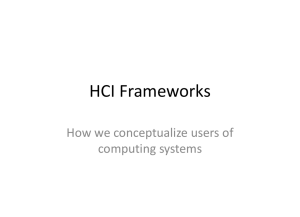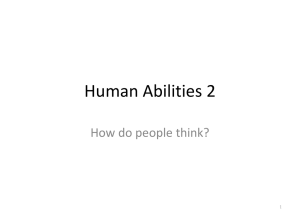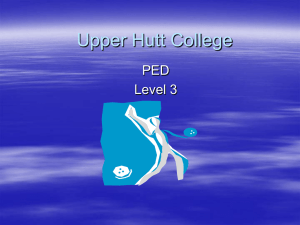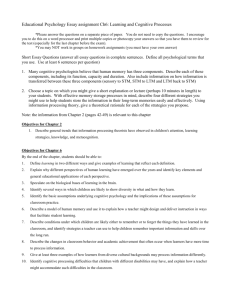Human Abilities John Stasko Spring 2007
advertisement
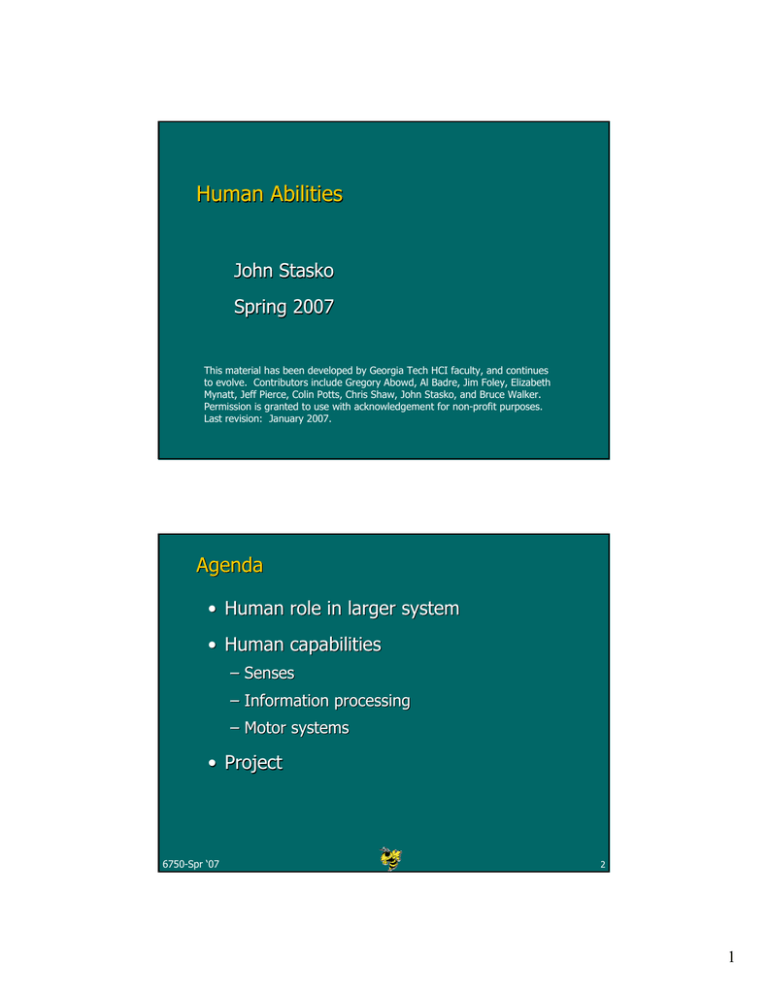
Human Abilities John Stasko Spring 2007 This material has been developed by Georgia Tech HCI faculty, and continues to evolve. Contributors include Gregory Abowd, Al Badre, Jim Foley, Elizabeth Mynatt, Jeff Pierce, Colin Potts, Chris Shaw, John Stasko, and Bruce Walker. Permission is granted to use with acknowledgement for non-profit purposes. Last revision: January 2007. Agenda • Human role in larger system • Human capabilities – Senses – Information processing – Motor systems • Project 6750-Spr ‘07 2 1 Human Role • How is human viewed in HCI – What is human role? • Different roles engender different frameworks 6750-Spr ‘07 3 Human Roles • Human considered to be a… • 1. Sensory processor – Experimental psych, sensory psych • e.g. ModelModel-Human Processor (Card, Moran & Newell) • 2. Interpreter/Predictor – Cognitive psych, AI • e.g. Distributed cognition (Hutchins) • 3. Actor in environment – Activity theory, ethnography, ecol psych • e.g. Situated action (Suchman (Suchman)) • e.g. Activity theory (Vygotsky (Vygotsky,, Nardi) Nardi) 6750-Spr ‘07 4 2 What Makes a System Usable Human considered to be a… Usability results when the system… Sensory processor Fits within human limits Interpreter/Predictor Fits with knowledge Actor in environment Fits with task and social context 6750-Spr ‘07 5 Evaluation Methods Human considered Evaluation methods… to be a… Sensory processor Quantitative experiments Interpreter/Predictor Task analysis, cognitive walkthrough Actor in environment Ethnographic field work, participatory design 6750-Spr ‘07 6 3 Two Views of Interaction • Interaction with – Software system is a tool or machine – Interface is a usabilityusability-engineered membrane – HumanHuman-asas-processor & -interpreter models • Interaction through – Software is a medium used to interact with task objects or other people – Interface plays a role in social context – HumanHuman-asas-interpreter & -actor models 6750-Spr ‘07 7 What are Humans Really Like? • Models of behavior are only part of the information we need for successful design • Need to know how users really are • Abilities, needs, preferences 6750-Spr ‘07 8 4 Human Capabilities • Why do we care? (better design!) • Want to improve user performance Time and effort expended to complete tasks • Knowing the user informs the design – Senses – Information processing systems – Physical responding 6750-Spr ‘07 9 Overview I. Senses A. Vision B. Hearing C. Touch D. Smell? 6750-Spr ‘07 II. Information processing A. Perceptual B. Cognitive 1. Memory a. Short term b. Medium term c. Long term 2. Processes a. Selective attention b. Learning c. Problem solving d. Language C. Motor system III. Motor system 10 5 I. Senses • Sight, hearing, touch important for current HCI – smell, taste ??? • Abilities and limitations affect design 6750-Spr ‘07 11 Key concepts for Senses Just noticeable difference (jnd) How much of a change in stimulus is needed before can be sensed Tends to be logarithmic - Weber’s Law Magnitude of physical stimulus versus perceived magnitude (Doubling number of photons does not double perceived intensity) 6750-Spr ‘07 12 6 Vision • Visual System – Eye – Retina – Neural pathway • ~ 80% of brain’s operation 6750-Spr ‘07 13 Visual Abilities • Sensitivity – luminance: 10-6~107 mL • Acuity – detection, alignment, recognition (visual angle) – retinal position: fovea has best acuity • Movement – tracking, reading, vibrations • Note: Vision decreases with age • Implications (??) – Font size & location depends on task – Much done by context & grouping 6750-Spr ‘07 14 7 Physiological Fundamentals • Retina has – 6.5 M cones (color vision), mostly at fovea (1/3)˚ – About 150,000 cones per square millimeter – Fewer blue sensing cones than red and green at fovea – 100 M rods (night vision), spread over retina, none at fovea • Adaptation – Switching between dark and light causes fatigue 6750-Spr ‘07 15 Color • Sensory response to electromagnetic radiation in the spectrum between wavelengths 0.4 - 0.7 micrometers 10-6 gamma 6750-Spr ‘07 10-1 0.5 105 108 ultraviolet visible microwave tv 16 8 Color Vision • Color & the retina – 380 (blue) ~ 770nm (red) – Problems with cones or ganglion cells causes problems with color perception – (Not really “color blindness”) • 8% males, 0.5% females • Implications (??) – Avoid saturated colors – Color coding should be redundant when possible 6750-Spr ‘07 17 Color/Intensity Discrimination • The 9 hues most people can identify are: 6750-Spr ‘07 Color Wavelength Red 629 RedRed-Orange 596 YellowYellow-Orange 582 GreenGreen-Yellow 571 YellowYellow-Green 538 Green 510 BlueBlue-Green 491 Blue 481 VioletViolet-Blue 460 18 9 Color Surround Effect • Our perception of a color is affected by the surrounding color 6750-Spr ‘07 19 Color Surround 6750-Spr ‘07 20 10 Hearing • Capabilities (best-case scenario) – pitch - frequency (20 - 20,000 Hz) – loudness - amplitude (30 - 100dB) – location (5° source & stream separation) – timbre - type of sound (lots of instruments) • Often take for granted how good it is (disk whirring) • Implications (??) 6750-Spr ‘07 21 Touch • Three main sensations handled by different types of receptors: – Pressure (normal) – Intense pressure (heat/pain) – Temperature (hot/cold) • Sensitivity, Dexterity, Flexibility, Speed • Where important? – Mouse, Other I/O, VR, surgery 6750-Spr ‘07 22 11 Smell Joseph Kaye, “Making scents: aromatic output for HCI” ACM Interactions Volume 10, Number 1 (2004), Pages 4848-61 Solenoid-controlled scent bottles 6750-Spr ‘07 23 II. Information Processing • How do people think? 6750-Spr ‘07 24 12 Typical Person :^) 6750-Spr ‘07 25 Information Processing • Three major systems of human information processing: – Perceptual (read-scan) – Cognitive (think) – Motor system (respond) 6750-Spr ‘07 26 13 1. Perceptual • Memory structures – Sensory buffer - Holds fixed image of outside world long enough for some analysis (will come back to this) • Processes - Info goes to brain for more processing – e.g. Pattern recognition – Uses context & knowledge 6750-Spr ‘07 27 2. Cognitive • Cognitive model – How does it work? 6750-Spr ‘07 28 14 Memory • Four “types” – Perceptual “buffers” Chess • Brief impressions – ShortShort-term memory • Conscious thought, calculations – Intermediate • Storing intermediate results, future plans – LongLong-term • Permanent, remember everything ever happened to us 6750-Spr ‘07 29 Perceptual Store • Visual and auditory impressions – visuospatial sketchpad, phonological loop • Very brief, but veridical representation of what was perceived – Details decay quickly (~.5 sec) – Rehearsal prevents decay – Another task prevents rehearsal 6750-Spr ‘07 30 15 Short-term memory • Use “chunks”: 4-5 units (not 7±2) • Display format should match memory system used to perform task • New info can interfere with old info • Exercises – My name is John, I like … – Numbers 6750-Spr ‘07 31 Long-term Memory • Seemingly permanent & unlimited File system full • Access is harder, slower – -> Activity helps (we have a cache) 6750-Spr ‘07 32 16 LT Memory Structure • Episodic memory – Events & experiences in serial form • Helps us recall what occurred • Semantic memory – Structured record of facts, concepts & skills • One theory says it’s like a network • Another uses frames & scripts (like record structs) structs) 6750-Spr ‘07 33 Memory Characteristics • Things move from STM to LTM by rehearsal & practice and by use in context Unclear if we ever really forget something Lack of use • We “forget” things due to decay and interference Similar gets in way of old 6750-Spr ‘07 Exercise 34 17 Exercises • Some fun... 6750-Spr ‘07 35 Processes • Four main processes of cognitive system: – Selective Attention – Learning – Problem Solving – Language 6750-Spr ‘07 36 18 1. Selective Attention • We can focus on one particular thing – Cocktail party chit-chat • Salient visual cues can facilitate s.a. – Examples? Boldface, blinking and beeping • Visual or Auditory Streams form after a few seconds 6750-Spr ‘07 37 2. Learning • Two types: – Procedural – How to do something – Declarative – Facts about something • Involves – Understanding concepts & rules – Memorization – Acquiring & automating motor skills • Bike riding, typing, tennis 6750-Spr ‘07 38 19 Learning • Facilitated – By analogy – By structure & organization – If presented in incremental units – Repetition • Hindered by – Previous knowledge (move from Mac to Windows) • ---> Use user’s previous knowledge in interface 6750-Spr ‘07 39 Observations • Users focus on getting job done, not learning to effectively use system • Users apply analogy even when it doesn’t apply 6750-Spr ‘07 40 20 3. Problem Solving • Storage in LTM, then application • Reasoning – Deductive- If A, then B – Inductive- Generalizing from previous cases to learn about new ones – Abductive- Reasons from a fact to the action or state that caused it 6750-Spr ‘07 41 Reasoning about a UI • Deductive: If I want to delete something, I must first select it. Facilitate by animating the disappearance of selected object • Inductive: I could make text bold by selecting it and then using the Bold command. Maybe I could italicize in the same way. Facilitate by putting bold and italic commands together • Abductive:Timeout on the web browser if not connected. Facilitate by telling the user why the timeout occurred 6750-Spr ‘07 42 21 Observations • People are more heuristic than algorithmic – Try a few quick shots rather than plan • Resources simply not available • People often choose suboptimal strategies for low priority problems • People learn better strategies with practice 6750-Spr ‘07 43 Implications • Allow flexible shortcuts – Forcing plans will bore user • Allow multiple ways of doing • Provide active rather than passive help – Recognize dead ends and inefficient methods 6750-Spr ‘07 44 22 4. Language • Rule-based – How do you make plurals? • Productive – We make up sentences • Key-word and positional – Patterns • Should systems have natural language interfaces? 6750-Spr ‘07 45 People • Good 6750-Spr ‘07 • Bad 46 23 People • Good • Bad – Infinite capacity LTM – Limited capacity STM – LTM duration & complexity – Limited duration STM – HighHigh-learning capability – Unreliable access to LTM – Powerful attention mechanism – ErrorError-prone processing – Powerful pattern recognition – Slow processing 6750-Spr ‘07 47 III. Motor System • Capabilities – Range of movement, reach, speed, strength, dexterity, accuracy • Often cause of errors – Wrong button – DoubleDouble-click vs. single click • Principles – Feedback is important – Minimize eye movement 6750-Spr ‘07 48 24 Work Station Ergonomics – to Facilitate I/O 6750-Spr ‘07 49 Recap I. Senses A. Sight B. Sound C. Touch D. Smell? 6750-Spr ‘07 II. Information processing A. Perceptual B. Cognitive 1. Memory a. Short term b. Medium term c. Long term 2. Processes a. Selective attention b. Learning c. Problem solving d. Language C. Motor system III. Motor 50 25 Project • Part 0 – Topics • Part 1 - Understanding the problem – – – – – – – Work with client Understand users, their tasks, environment Informal evaluation of current interface, if it exists Establish objectives, requirements for design Implications of what you learn! No design! No assumptions! Read project description • Make a nice top coco-web page 6750-Spr ‘07 51 Upcoming • Predictive Evaluation • Understanding Users • Task Analysis & Requirements Gathering 6750-Spr ‘07 52 26
